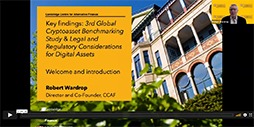Apolline Blandin, Dr. Gina Pieters, Yue Wu, Thomas Eisermann, Anton Dek, Sean Taylor and Damaris Njoki.
This report reviews the impact of significant changes in the industry since the publication of the 2nd Global Cryptoasset Benchmarking Study in 2018. It provides novel insights into the state of the cryptoasset industry, having gathered data from 280 companies in 59 countries and across four main market segments – exchanges, payments, custody and mining.
Highlights from the report
- Full-time equivalent (FTE) employee growth slowed considerably following the late-2017 market frenzy. Respondents across all market segments, reported year-on-year growth of 21 per cent in 2019, down from 57 per cent in 2018.
- The survey findings estimate that on average 39 per cent of proof-of-work mining is powered by renewable energy, primarily hydroelectric energy. Understanding the energy source of mining is important because electricity costs account for the majority of hashers’ operational expenditures – albeit with some variability across world regions – and hashers have long competed on accessing the cheapest energy source.
- Aligned with 2018 findings, new survey data shows that off-chain transactions, both in terms of volumes and numbers, continue to be dominated by fiat-cryptoasset trades (and vice-versa), meaning that users primarily interact with service providers, such as exchanges, to enter and leave the cryptoasset ecosystem.
- Stablecoins are becoming increasingly available. The share of service providers supporting Tether grew from four per cent to 32 per cent between 2018 and 2020, compared to 11 per cent to 55 per cent support growth for non-Tether stablecoins. This is aligned with the rising value of transactions denominated in stablecoins.
- Service providers operationally headquartered in North America and Europe indicate that business and institutional clients make up 30 per cent of their customers. This figure is much lower for APAC and Latin American firms at 16 per cent and 10 per cent respectively.
- The share of cryptoasset-only companies that did not conduct any KYC checks at all dropped from 48 per cent to 13 per cent between 2018 and 2020, most likely resulting from the progressive harmonisation of KYC/AML standards across jurisdictions, such as initiated by the Financial Action Task Force (FATF). The inclusion of firms exclusively supporting cryptoassets featured in FATF’s updated standards and recommendations is believed to have spurred greater compliance among this group of firms. However, this should not be interpreted as these companies becoming fully KYC compliant as some KYC checks are only applied to a subset of consumers.


